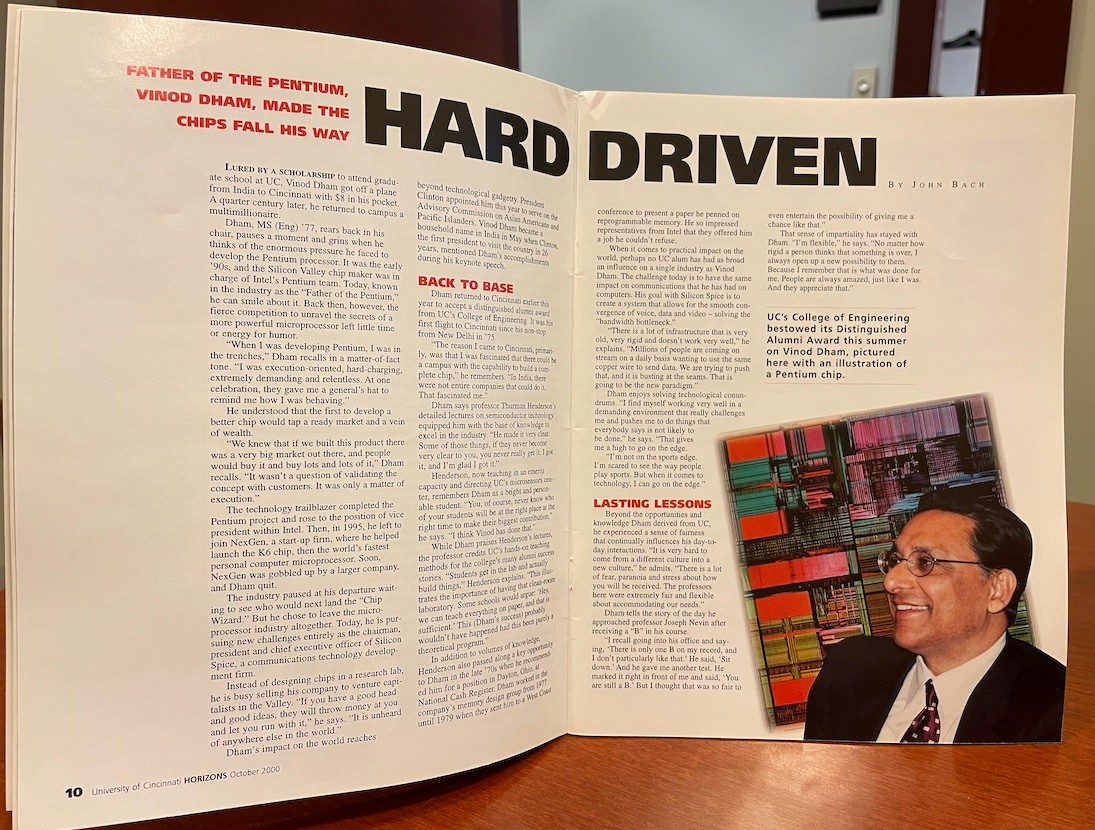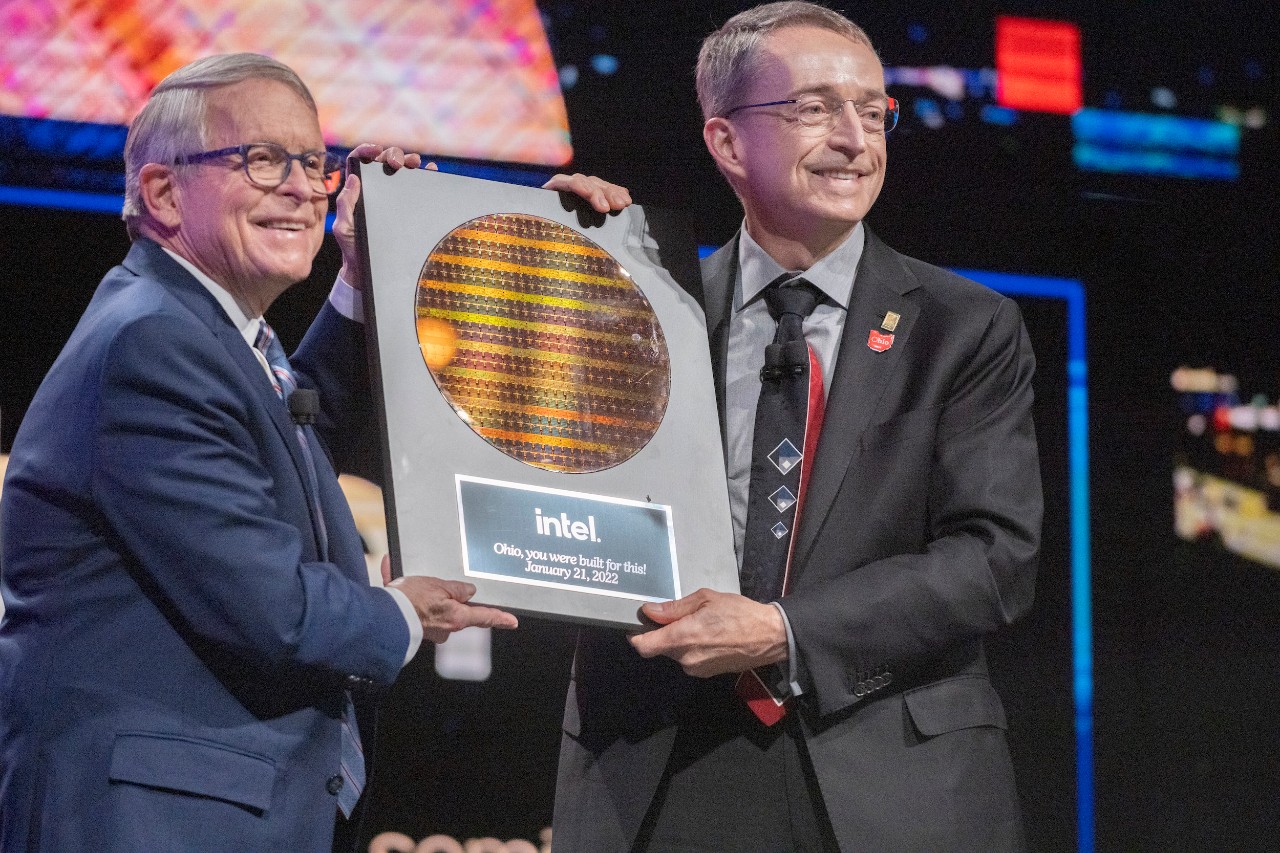
Tech Throwback: Alumnus and former Intel exec Vinod Dham known as 'Father of Pentium'
University of Cincinnati College of Engineering and Applied Science graduate led '90s Pentium team
In honor of Intel's move to build the "Silicon Heartland" in Ohio, we've tapped into UC's archive to share a profile of alumnus Vinod Dham, the corporation's former VP who became known as the "Father of the Pentium."
It is one of UC's many connections to the corporation, including a steady pipeline of co-ops who gain tremendously valuable real-world experience at Intel. Last month the microchip giant announced it is building a $20 billion manufacturing facility near New Albany, Ohio, the beginning of what could become a $100 billion investment.
The below profile of UC graduate Vinod Dham was originally printed in the October, 2000 edition of the university magazine.
HARD DRIVEN
Lured by a scholarship to attend graduate school at UC, Vinod Dham got off a plane from India to Cincinnati with $8 in his pocket. A quarter century later, he returned to campus a multimillionaire.
Dham, MS (Eng) '77, rears back in his chair, pauses a moment and grins when he thinks of the enormous pressure he faced to develop the Pentium processor. It was the early '90s, and the Silicon Valley chip maker was in charge of Intel's Pentium team. Today, known in the industry as the "Father of the Pentium," he can smile about it. Back then, however, the fierce competition to unravel the secrets of a more powerful microprocessor left little time or energy for humor.

This UC magazine article featured UC alumnus Vinod Dham following a sit-down interview during his UC visit to accept the Distinguished Alumni Award from the College of Engineering and Applied Science in 2000.
"When I was developing Pentium, I was in the trenches," Dham recalls in a matter-of-fact tone. "I was execution-oriented, hard-charging, extremely demanding and relentless. At one celebration, they gave me a general's hat to remind me how I was behaving."
He understood that the first to develop a better chip would tap a ready market and a vein of wealth.
"We knew that if we built this product there was a very big market out there, and people would buy it and buy lots and lots of it," Dham recalls. "It wasn't a question of validating the concept with customers. It was only a matter of execution."
The technology trailblazer completed the Pentium project and rose to the position of vice president within Intel. Then, in 1995, he left to join NexGen, a start-up firm, where he helped launch the K6 chip, then the world's fastest personal computer microprocessor. Soon, NexGen was gobbled up by a larger company, and Dham quit.
The industry paused at his departure waiting to see who would next land the "Chip Wizard." But he chose to leave the microprocessor industry altogether. Today, he is pursuing new challenges entirely as the chairman, president and chief executive officer of Silicon Spice, a communications technology development firm.
Instead of designing chips in a research lab, he is busy selling his company to venture capitalists in the Valley. "If you have a good head and good ideas, they will throw money at you and let you run with it," he says. "It is unheard of anywhere else in the world."
Dham's impact on the world reaches beyond technological gadgetry. President Clinton appointed him this year to serve on the Advisory Commission on Asian Americans and Pacific Islanders. Vinod Dham became a household name in India in May when Clinton, the first president to visit the country in 26 years, mentioned Dham's accomplishments during his keynote speech.

Ohio Gov. Mike Dewine (left) accepts a silicon wafer from Intel CEO Pat Gelsinger on January 21, 2022, in Licking County, Ohio, during an event to announce Intel’s plans for an initial investment of more than $20 billion in construction of two new leading-edge chip factories. The project’s initial phase is expected to create 3,000 Intel jobs and 7000 construction jobs. Photo/Walden Kirsch/Intel Corporation
Back to base
When Vinod Dham returned to UC earlier this year [summer of 2000] to accept a distinguished alumni award from the College of Engineering, it was his first flight to Cincinnati since his non-stop from New Delhi in '75.
"The reason I came to Cincinnati, primarily, was that I was fascinated that there could be a campus with the capability to build a complete chip," he remembers. "In India, there were not entire companies that could do it. That fascinated me."
Dham, now considered the "Father of the Pentium," says professor Thurman Henderson's detailed lectures on semiconductor technology equipped him with the base of knowledge to excel in the industry. "He made it very clear. Some of those things, if they never become very clear to you, you never really get it. I got it, and I'm glad I got it."
Henderson, now teaching in an emeriti capacity and directing UC's microsensors center, remembers Dham as a bright and personable student. "You, of course, never know who of your students will be at the right place at the right time to make their biggest contribution," he says. "I think Vinod has done that."
While Dham praises Henderson's lectures, the professor credits UC's hands-on teaching methods for the college's many alumni success stories. "Students get in the lab and actually build things," Henderson explains. "This illustrates the importance of having that clean-room laboratory. Some schools would argue: 'Hey, we can teach everything on paper, and that is sufficient.' This (Dham's success) probably wouldn't have happened had this been purely a theoretical program."
In addition to volumes of knowledge, Henderson also passed along a key opportunity to Dham in the late '70s when he recommended him for a position in Dayton, Ohio, at National Cash Register. Dham worked in the company's memory design group from 1977 until 1979 when they sent him to a West Coast conference to present a paper he penned on reprogrammable memory. He so impressed representatives from Intel that they offered him a job he couldn't refuse.
When it comes to practical impact on the world, perhaps no UC alum has had as broad an influence on a single industry as Vinod Dham. The challenge today is to have the same impact on communications that he has had on computers. His goal with Silicon Spice, his communications technology development firm, is to create a system that allows for the smooth convergence of voice, data and video -- solving the "bandwidth bottleneck."
"There is a lot of infrastructure that is very old, very rigid and doesn't work very well," he explains. "Millions of people are coming on stream on a daily basis wanting to use the same copper wire to send data. We are trying to push that, and it is busting at the seams. That is going to be the new paradigm." Dham enjoys solving technological conundrums. "I find myself working very well in a demanding environment that really challenges me and pushes me to do things that everybody says is not likely to be done," he says. "That gives me a high to go on the edge.
"I'm not on the sports edge. I'm scared to see the way people play sports. But when it comes to technology, I can go on the edge."
Lasting lessons
Beyond the opportunities and knowledge Dham derived from UC, he experienced a sense of fairness that continually influences his day-to-day interactions. "It is very hard to come from a different culture into a new culture," he admits. "There is a lot of fear, paranoia and stress about how you will be received. The professors here were extremely fair and flexible about accommodating our needs."
Dham tells the story of the day he approached professor Joseph Nevin after receiving a "B" in his course.
"I recall going into his office and saying, 'There is only one B on my record, and I don't particularly like that.' He said, 'Sit down.' And he gave me another test. He marked it right in front of me and said, 'You are still a B.' But I thought that was so fair to even entertain the possibility of giving me a chance like that."
That sense of impartiality has stayed with Dham. "I'm flexible," he says. "No matter how rigid a person thinks that something is over, I always open up a new possibility to them. Because I remember that is what was done for me. People are always amazed, just like I was. And they appreciate that."
Featured image at top: Rendering of Intel's $20 billion facility planned for New Albany, Ohio. The project represents the largest private investment in the state's history. Image provided
Impact Lives Here
The University of Cincinnati is leading public urban universities into a new era of innovation and impact. Our faculty, staff and students are saving lives, changing outcomes and bending the future in our city's direction. Next Lives Here.
Related Stories
New Dungeons & Dragons ethics seminar takes flight
July 7, 2025
On a blisteringly hot summer day, laughter echoed through the cool, damp basement of the Avondale branch of the Cincinnati Public Library. Young teenagers huddled around a table littered with pencils and paper, rolling dice and bonding over a game of Dungeons & Dragons. University of Cincinnati undergraduate student Charitha Anamala sat behind a trifold card with a blazing red dragon on it, serving as the group’s Dungeon Master (DM) or campaign organizer. Within the fantasy setting she described, it was hard to tell the adventure was a lesson in ethics.
Career planning for college students: Year-by-year guide
Discover a year-by-year college career planning guide to help you explore interests, gain experience and confidently prepare for life after graduation at UC.
CCM alumnus wins Armenia’s Khachaturian Conducting Competition
July 1, 2025
UC College-Conservatory of Music alumnus Fernando Gaggini (MM Orchestral Conducting. '19) recently won First Prize and the Audience Award at the 21st Khachaturian International Conducting Competition in Yerevan, Armenia. From a pool of over 250 applicants representing 25 countries, 17 conductors were invited to participate in the live rounds of the competition, held June 6–12, 2025.
